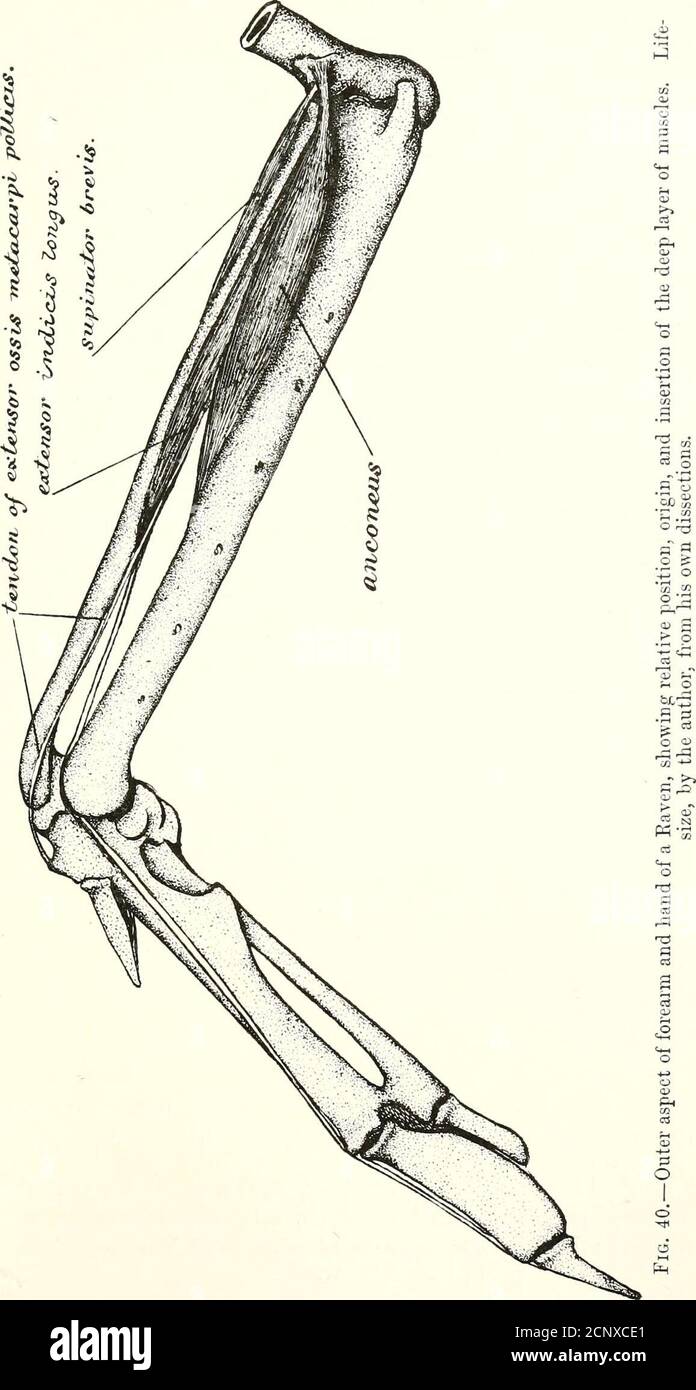. The myology of the raven (Corvus corax sinuatus.) A guide to the study of the muscular system in birds . scle, occupying rather more than the posteriorhalf of the under side of the forearm. From the an-terior apex of this muscle a powerful and subcylindricaltendon stretches directly to the back of the nlnare ossi-cle of the carpus, where it makes an extensive attach-ment. Just before reaching this ossicle the tendon ofthe flexor carpi ulnaris differentiates off a small tendi-nous slip, wdiich, passing through a fibrous loop at theulnar side of the carpus, goes obliquely downwards tothe tendo

Image details
Contributor:
Reading Room 2020 / Alamy Stock PhotoImage ID:
2CNXCE1File size:
7.2 MB (262.9 KB Compressed download)Releases:
Model - no | Property - noDo I need a release?Dimensions:
1157 x 2161 px | 19.6 x 36.6 cm | 7.7 x 14.4 inches | 150dpiMore information:
This image could have imperfections as it’s either historical or reportage.
. The myology of the raven (Corvus corax sinuatus.) A guide to the study of the muscular system in birds . scle, occupying rather more than the posteriorhalf of the under side of the forearm. From the an-terior apex of this muscle a powerful and subcylindricaltendon stretches directly to the back of the nlnare ossi-cle of the carpus, where it makes an extensive attach-ment. Just before reaching this ossicle the tendon ofthe flexor carpi ulnaris differentiates off a small tendi-nous slip, wdiich, passing through a fibrous loop at theulnar side of the carpus, goes obliquely downwards tothe tendon of the flexor dlgitoriiin profundus, andmerges with it at a point about opposite the distal apexof the pollex digit; or, more strictly speaking, is con-tained in the same sheath with this tendon of the flexordigitorum profundus tendon as far as the anterior rimof the proximal phalanx of the index digit, where thisoffshoot becomes inserted. In its action this muscle is a powerful flexor of thehand upon the forearm, and its tendinous offshoot atthe carpus is not an inefficient aid to the action of the. 144 THE MYOLOGY OF THE RAYEX. flexor dlgitorura j^rofundus. Owen calls this muscle theflexor metacarpi idnaris, and says of it in the Apteryxthat it arises beneath the forearm from the internalpulley of the ulna ; continues fleshy to the pinion ; andis inserted, first into the ulnar carpal bone, then into theulnar phalanx. The latter insertion is wanting both inthe Ostrich and Penguin {Anaf. Verts., vol, ii. p. 99). When we come to examine it carefully in the Raven, especially the distinctness of its external head, and amedian fascia that runs longitudinally through its belly, and finally its distal tendinous ofishoot, it is not difficultfor us to imagine that the muscle originally was com-posed of two parts, or perhaps two distinct muscles(Figs. 31 and 36). 84. The flexor caipi idnaris hrevior^ is a musclethat I do not find described in any work at presentavailable to me, and whic